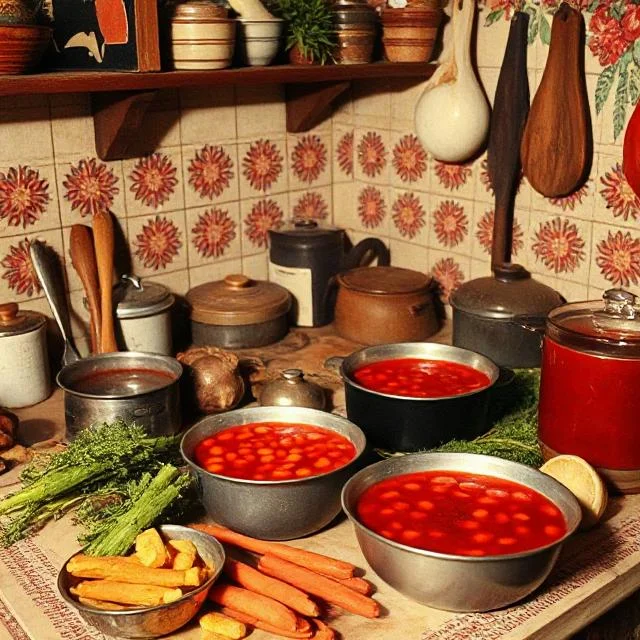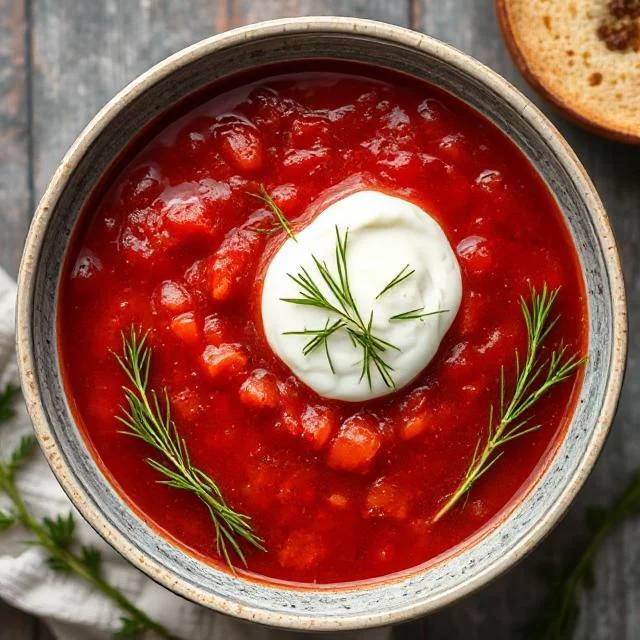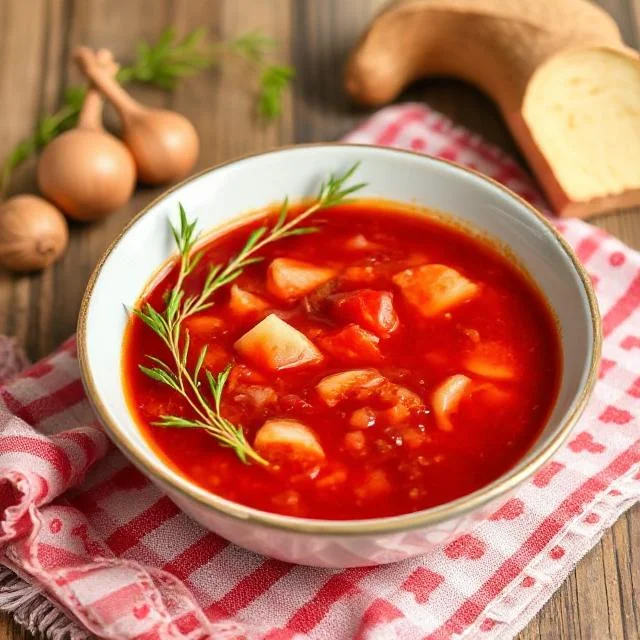Introduction: What Is Borscht?
Borscht is a classic Eastern European soup made with beets, which give it its signature vibrant red color. This dish has been a staple in the region for centuries, known for its hearty texture and deep, earthy flavor. Whether served hot or cold, Beet soup is a versatile, nourishing, and delicious meal. In this guide, we’ll explore the rich history of Beet soup, its essential ingredients, how to make it at home, its health benefits, and the unique variations around the world.
The Origins of Borscht: A Timeless Eastern European Dish
The History of Beet soup: A Tradition Across Generations
Ukrainian soup dates back to ancient times and originated in Ukraine. Initially made with wild beets, it evolved into a common dish across Eastern Europe, with each region adding its own twist, contributing to the dish’s rich heritage.

A vintage image of Soup preparation in an Eastern European kitchen
Key Ingredients in Borscht: The Essential Elements
The core ingredients of Red beet soup include beets, cabbage, onions, and sometimes meat like beef, pork, or chicken. The soup is seasoned with garlic, dill, and vinegar, balancing the sweetness of the beets with savory and tangy flavors.
How Borscht Is Served: Hot, Cold, and Garnished
Red beet Soup is often served with a dollop of sour cream and fresh dill. It can be enjoyed hot during the colder months or served cold as a refreshing summer dish. Paired with garlic bread or rye, it makes for a complete meal.
Regional Variations of Borscht: Unique Twists Across Eastern Europe
Though the basic components of Red beet soup remain the same, each country has its variations. Ukrainian borscht may feature beef, while Russian borscht often includes pork. Polish borscht is typically vegetarian, providing a lighter alternative.
How to Make Borscht at Home: A Simple and Delicious Recipe
Step 1: Preparing the Base for Your Borscht
Start by sautéing onions, carrots, and beets in a large pot with oil. Once softened, add garlic and cook until fragrant. This base creates a rich and flavorful foundation for your Slavic beet soup.
Step 2: Adding Broth and Vegetables for Full Flavor
Once the base is ready, pour in vegetable or beef broth and add potatoes and cabbage. Simmer until the vegetables are tender and the flavors have melded together. Season with salt, pepper, and a dash of vinegar.
Step 3: Finishing Touches: Garnishing with Sour Cream and Dill
When your Slavic beet soup is ready, serve it with a dollop of sour cream and a sprinkle of fresh dill. The sour cream adds richness, while the dill enhances the flavor with its fresh, herbal notes.

A bowl of homemade beet soup, topped with sour cream and dill
Health Benefits of Borscht: Why It’s Good for You
How Beets Make Borscht a Nutrient-Rich Delight
Beets, the star ingredient of Ukrainian soup, are packed with essential nutrients like folate, manganese, and potassium. Beets are also rich in antioxidants and nitrates, which have been shown to improve circulation and lower blood pressure.
Low-Calorie, High-Fiber Soup: Ideal for Weight Management
Ukrainian soup is a low-calorie, high-fiber soup, especially from the beets, cabbage, and potatoes. The fiber helps with digestion and keeps you feeling full longer, making it a great option for those looking to manage their weight.
Immune-Boosting Ingredients in Borscht
The combination of garlic, onions, and beets provides immune-boosting benefits. Garlic is known for its antibacterial and antiviral properties, while onions are rich in vitamin C, which supports immune function.
Vegan and Vegetarian Borscht: Plant-Based Versions of This Classic Soup
Making a Vegan Borscht: Substituting Meat and Broth
To create a vegan version of Beet soup, replace the meat with plant-based proteins and use vegetable broth instead of meat stock. The rest of the recipe remains the same, ensuring you still enjoy the authentic flavors of this traditional soup.
Adding Plant-Based Protein to Vegan Borscht
Boost the protein content of vegan Red beet soup by adding lentils, tofu, or tempeh. These additions increase the soup’s nutritional value and make it more filling.
Flavor Variations in Vegan Borscht: Experimenting with Spices
For an extra kick, add spices like smoked paprika or caraway seeds. These spices bring depth and complexity to your vegan red beet soup, enhancing its flavor profile.
Global Variations of Borscht: How It’s Made Around the World
Ukrainian Borscht: A Rich, Meaty Tradition
Ukrainian soup is the most well-known version, often made with beef and served piping hot. It’s typically accompanied by garlic bread or rye, making it a hearty and satisfying meal.
Russian Borscht: A Pork-Based Delight
Russian soup, while similar to the Ukrainian version, often includes pork and sometimes mushrooms. It’s a rich, comforting soup served with a dollop of sour cream.
Polish Borscht: A Lighter, Vegetarian Soup
Polish borscht is typically vegetarian, made with a clear broth and no meat. It’s often served with boiled potatoes or small dumplings, offering a lighter alternative to the meaty variations.
Conclusion: Why Borscht Should Be Part of Your Meal Plan
Borscht is a timeless, nutritious dish that has stood the test of time in Eastern European cultures. Whether you enjoy it hot or cold, with meat or as a vegan option, borscht is a versatile meal that provides comfort, flavor, and health benefits. Now that you know the history, ingredients, and health advantages of Ukrainian soup, it’s time to try making this delicious dish at home and enjoy its rich, satisfying flavors!
Advice
Borscht is a hearty, flavorful soup that’s a staple in many Eastern European kitchens, known for its vibrant red color and earthy taste. To make a traditional borscht, start with beets, which give the soup its signature color and rich, slightly sweet flavor. Begin by sautéing onions, carrots, and garlic in oil, then add the beets, cabbage, and potatoes, letting them simmer in broth (vegetable or beef) until tender. The key to a great borscht is balancing the sweetness of the beets with a touch of acidity—this is where vinegar or lemon juice comes in. For an authentic touch, serve your borscht with a dollop of sour cream and a sprinkle of fresh dill. This comforting dish is not only delicious but also packed with nutrients, making it a perfect addition to your cooking repertoire!

